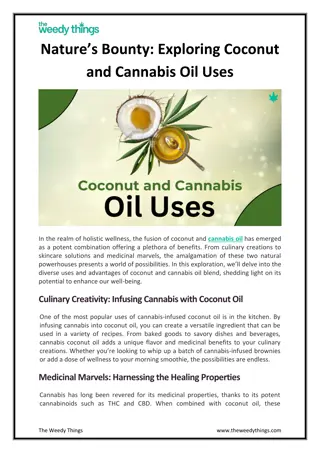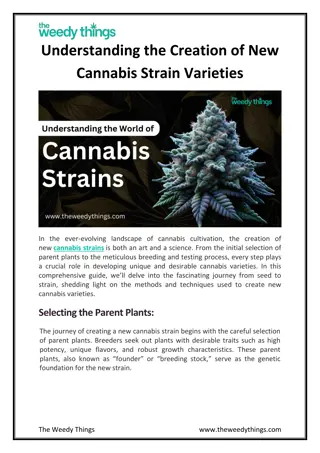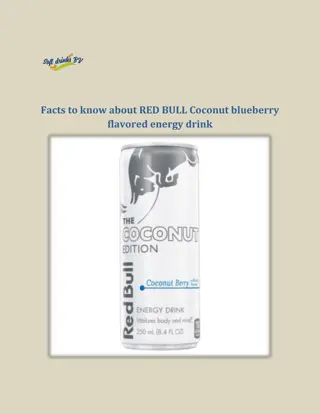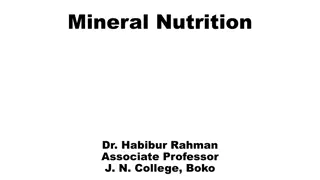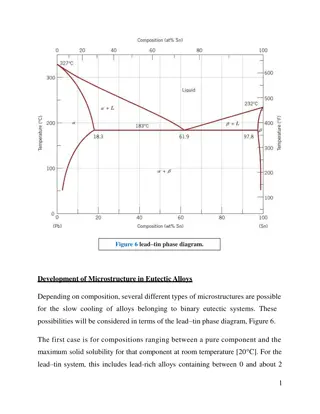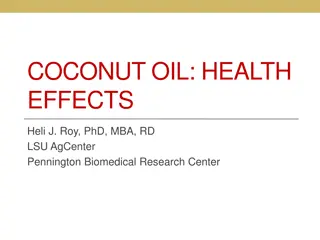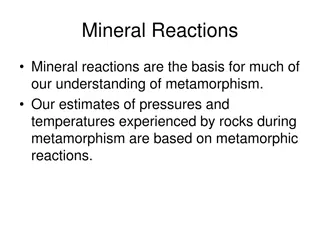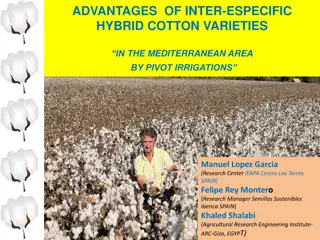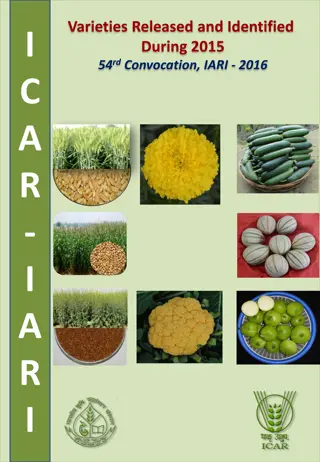Comparative Analysis of Proximate Compositions and Mineral Contents of Coconut Varieties
Coconut, a valuable source of nutrients, is a staple food for many cultures globally. This study compares the nutritional compositions of different coconut varieties, highlighting their rich fiber, vitamin, and mineral content. The research delves into the significance of coconut oil and its medicinal properties, emphasizing the diverse applications and benefits of various coconut products in promoting health and well-being.
Download Presentation

Please find below an Image/Link to download the presentation.
The content on the website is provided AS IS for your information and personal use only. It may not be sold, licensed, or shared on other websites without obtaining consent from the author.If you encounter any issues during the download, it is possible that the publisher has removed the file from their server.
You are allowed to download the files provided on this website for personal or commercial use, subject to the condition that they are used lawfully. All files are the property of their respective owners.
The content on the website is provided AS IS for your information and personal use only. It may not be sold, licensed, or shared on other websites without obtaining consent from the author.
E N D
Presentation Transcript
COMPARISON OF PROXIMATE COMPOSITIONS AND NUTRITIONALLY VALUABLE MINERAL CONTENTS OF SELECTED COCONUT VARIETIES Presented at the 7th CAPCDR International Conference on "Public Health and Technology" By OMIMAKINDE Elizabeth Adeteju National Center for Technology Management, OAU, Ile-Ife, Nigeria.
OUTLINE Introduction and Literature Review Research Methodology Result and Discussion Conclusion References
Introduction and Literature Review Coconut provides a nutritious source of juice, milk, minerals, and oil that has fed and nourished populations around the world for generations. On many islands, coconut is a staple in the diet and provides much of the food eaten. Nearly one-third of the world s population depends on coconut to some degree for food and economy. Among these cultures, coconut has a long and respectful history (Codjoe et al., 2021; Oduro-Yeboah et al., 2020).
Introduction and Literature Review Contd Coconut is highly nutritious and rich in fibre, vitamins, and minerals. It is classified as a functional food because it provides many health benefits beyond its nutritional content (Kaur et al., 2019). Coconut oil is of special interest because it possesses healing properties far beyond that of any other dietary oil. It is extensively used in traditional medicine among Asian and Pacific populations (Salian and Shetty, 2018)
Introduction and Literature Review Contd Coconut Meat is the kernel (endosperm) enclosed by the hard strong shell (endocarp) and to which the testa (thin brown seed coat) firmly adheres. It is normally a layer of about 12mm or thicker, lining the central cavity, which in the ripe nut is partly filled with water. Coconut Water is the water of tender coconut, technically, the liquid endosperm. The amount present depends upon the size, variety, maturity, and freshness of the coconut.
Introduction and Literature Review Contd Coconut Varieties: coconut is a diverse species, which is generally divided into two groups. These groups are the tall and dwarf varieties. What are called varieties are variable because the coconut cannot be propagated asexually but only by seed (Omotayo, 2020) thus all varieties are subject to some variations. Apart from the typical dwarf and tall types, there are intermediate types:
Introduction and Literature Review Contd Hybrid - the crossbreeding between tall and dwarf types. These have productive characteristics of tall and dwarf, which are superior to ordinary tall. Within these three categories, a distinction is also made by the colour of the fruit. Some of the varieties analyzed in this study are Dwarf Green, Dwarf Red and Dwarf Yellow, these are also applicable to the tall and hybrid types.
Introduction and Literature Review Contd ProximateAnalysis The routine analysis of food for its basic component is termed the proximate or Wende analysis; after the Wende Experiment station, Germany, developed in 1865 (Oyeleke, 1984). Estimations were made of nitrogen, (as an index of crude protein), water, fat, ash, and crude fibre. Carbohydrate content was taken to be the value obtained when the total of all other components was subtracted from a hundred percent
Introduction and Literature Review Contd Elemental Composition of Coconut Minerals are the inorganic matter. When a plant or animal tissue is bunt; the organic matter is destroyed leaving a residue known as ash. This represents the salt of the mineral element, which previously existed in the tissues in combination with the organic matter.
Introduction and Literature Review Contd Minerals in food are grouped into two categories, namely: Macro- minerals and Micro-minerals or trace elements. The macro-minerals are the ones that are required in large amounts in the body. They are required in an amount greater than 10mg per day (Khalid et al., 2014), these include Ca, Mg, K, and Na.
Introduction and Literature Review Contd Micro-minerals or trace elements refer to the inorganic elements which are present in foods in amounts usually well below 50ppm. Micro minerals occur at ppm levels or below and exert some influence on plants or animals physiological activities and cell functions. These include Cu, Mn, Cr, Co, etc. (Mousa et al, 2019)
Introduction and Literature Review Contd General Importance of Mineral Elements Although the quantities of minerals in the body are very tiny, their importance is correspondingly enormous. Minerals participate in a great number of enzymes and metabolic processes. Quantities in which they are found give no due as to how vital they are for health. Tiny quantities of selenium are in every bit as important as large quantity of calcium and magnesium. Minerals contribute to the building up of tissues. Calcium, to the building up of the bones and teeth
Introduction and Literature Review Contd Iron and copper are essential ingredients in haemoglobin and myoglobin in the blood. A vitamin B12molecule contains an atom of cobalt and iodine is vital to the functioning of the thyroid gland. Minerals are the cornerstones of thousands of enzymes and chemical compounds. Sodium and potassium have an influence on the osmotic pressure in the tissues and on the elimination of various fluids from living organisms (Robinson, 2015).
MATERIALS AND METHODS All the reagents used for this analysis were of analytical grade and were products of B.D.H Limited, and May and Baker Limited, England. All the glassware were washed with detergent solution, well rinsed with tap and distilled water respectively, and then oven-dried before use. Coconut samples of five varieties were obtained from the Nigeria Institute for Oil Palm Research (NIFOR), Badagry, Lagos State. They were de-husked, stacked in bags and transported to Poultry Meat Laboratory of the Faculty ofAgriculture, ObafemiAwolowo University, Osun State Nigeria for subsequent analysis.
MATERIALS AND METHODS Contd At the Laboratory, the coconut shells were carefully drilled at the indentation points The fluid was collected and filtered into air-tight sample bottles and then stored in the refrigerator for subsequent analysis. The meat was removed from the shells, washed, grated with a plastic grater. They were packed in airtight containers and refrigerated prior to analysis. Proximate and mineral compositions of the five varieties of coconuts were estimated using standard methods.
MATERIALS AND METHODS Contd The proximate analysis of the coconut samples covers crude protein, ether extract, moisture content, crude fibre, carbohydrate, and ash content. The mineral contents determined are sodium (Na), potassium (K), magnesium (Mg), calcium (Ca), iron (Fe), manganese (Mn), zinc (Zn), copper (Cu), cobalt (Co), and chromium (Cr). Atomic Absorption Spectroscopy (AAS) method was used to determine the mineral contents.
RESULT AND DISCUSSION ProximateAnalysis A significant difference was observed in the moisture content, crude fat, crude fibre, and total carbohydrate contents of the coconut samples. The Dwarf Green (DG) sample has the highest value of crude protein (3.54%). This is very close to the value of 3.8 % reported by McCance & Widdowson, (2014). DR has the lowest value of crude protein (2.66%). Although these values are very low, they are nevertheless; a potentially important source of protein because the high volume of the world s production of coconuts, occurs primarily in regions deficient in high-protein foods.
PROXIMATE COMPOSITION OF FRESH COCONUT MEAT (%) (Result and Discussion Contd) ASH MC CP EE CF CHO HM 1.07 + 0.11 44.15 + 0.54 2.99 +0.25 37.10 +0.78 3.44 +0.21 14.69 +1.47 TM 0.98 + 0.12 42.11 + 0.21 3.35 +0.45 34.05 +0.60 4.77 +.40 19.53 +0.072 DRM 0.87 + 0.21 51.27 +0.57 2.66 +0.25 27.95 +0.08 1.42 +0.19 17.15 +0.18 DYM 0.85 + 0.032 48.93 +.014 3.47 +0.033 30.05 +0.007 11.62 +0.65 16.70 +0.013 DGM 0.99 + .000 43.76 +0.74 3.54 +0.32 37.69 +0.42 5.78 +0.11 14.03 +0.84
RESULT AND DISCUSSION Contd The moisture contents of the varieties are 43.76 % for DG, 44.15% for H, and 48.93% for DY. DR had the highest moisture content of 51.27% and Tall with the lowest moisture content of 42.11%. The varieties have the following ash content: 0.98% (T), 0.87% (DR), and 0.99% (DG). H had the highest ash content of 1.07% while DY had the lowest ash content of 0. 85%.
RESULT AND DISCUSSION Contd Mineral Composition The mineral analyses of the various samples were shown in the table below. Sodium, potassium, calcium, iron, copper, magnesium, zinc, chromium, and manganese were detected in both coconut meat and water. Cobalt was detected in all the coconut meat samples except TM. Sodium and potassium contents in both meat and water samples were the highest, followed by calcium and magnesium (6.70-55.70, 2.24- 33.50mg/100g)
RESULT AND DISCUSSION Contd Others are less than 1mg/100g except zinc, which is between 1.49 and 2.74mg/100g respectively. Iron was not detected in DYW, DGW and DRW respectively while DYM has the highest level of iron (0.63mg/100g). Chromium was not detected in DRW, DRM and TM. The levels of trace metals (Cu, Co, Zn, Cr and Mn) are within the levels recommended for daily allowance (e.g., Mn: 3.8mg, Co:0. 008mg, Zn: l5mg, Cr: 0.6mg and Cu: 2.5- 7mg) (Udousoro, 2017). Coconut water samples are richer in calcium content than coconut meat samples, especially DRW and HW (55.70mg/100g and 33.73mg/100g).
Mineral Composition of Fresh Coconut Meat and Water Result and Discussion Contd
Mineral Composition of Fresh Coconut Meat and Water Result and Discussion Contd Na K Ca Fe Cu Co Mg Zn Cr Mn SAMPLES (mg/100g) (mg/100g) (mg/100g) (mg/100g) (mg/100g) (mg/100g) (mg/100g) (mg/100g) (mg/100g) (mg/100g) HM 82.03 95.46 7.4 0.425 0.59 0.025 20.28 1.6 0.013 0.55 TM 59.78 78.6 10.58 0.39 0.34 ND 22.28 1.49 ND 0.68 DRM 63.76 78.05 6.75 0.55 0.29 0.038 22.96 1.88 ND 0.98 DYM 31.91 104.16 7.20 0.63 0.95 0.013 27.28 2.75 0.025 0.88 DGM 80.35 104.16 11.01 0.4 0.49 0.025 28.33 1.76 0.063 0.75 HW 60.25 168.3 33.73 0.015 0.009 ND 18.49 0.026 0.018 0.25 TW 90.32 46.56 8.99 0.002 0.008 ND 18.82 0.01 0.011 0.26 DRW 71.77 133.67 55.7 ND 0.006 ND 33.5 0.019 ND 0.24 DYW 34.37 97.32 13.04 ND 0.002 ND 2.81 0.009 0.019 0.02 DGW 47.36 49.73 13.52 ND 0.009 ND 2.24 0.011 0.015 0.42
CONCLUSION Generally, results of the proximate analysis of coconut kernel grown at NIFOR did not differ significantly across the varieties. The result has demonstrated that coconut meat and water are good sources of fat, protein, and essential minerals and these can serve various health and economic purposes. It can also be deducted from the result of the proximate analysis that the hybrid type sample has characteristics between that of the dwarf and tall varieties. All the coconut varieties have one or more unique properties attributed to each of them. For the production of oil, dwarf yellow coconut will be a good source. Whereas dwarf green with the highest percentage of protein can be a good source of protein especially in regions of prevalence protein deficiency. Dwarf red contained the largest percentage of carbohydrate, therefore is a good source of energy.
REFERENCES 74. PMID: 24778671; PMCID: Abbaspour N, Hurrell R, Kelishadi R. (2014). Review on iron and its importance for human health. J Res Med Sci. 19(2):164- protein digestibility, enzyme inhibitor activity and amino acid profile of selected legume grains. Heliyon. 6. e05419. 10.1016/j.heliyon.2020.e05419. Adeleye, O., Ajayi, A., and Ogunmoyela, T. (2020). Effect of high-temperature, short-time cooking conditions on in vitro of Medicine 121(11). Pp. 943-948. doi: 10.1016/j.amjmed.2008.07.012. PMID: 18954837; PMCID: PMC2582401. Alleyne M., Horne M.K., Miller J. L. (2008). Individualized treatment for iron-deficiency anemia in adults. American Journal Leguminous Seeds Grown in Nigeria. International Journal of Science Vol. 6 No. 8 pp. 88-97. DOI:10.18483/ijSci.1390 Aremu M. O., Audu S. S., and Gav. L. (2017). Comparative Review of Crude Protein and Amino Acid Composition of Some By Adalya Journal Vol. 8, Issue 8, pp 515- 535. https://adalyajournal.com/gallery/56-aug-1697.pdf Banu R. H. and Palanivel S. (2019). Problems of Marketing Practices of Coconut Products in Thiruvarur District. Tamil Nadu
REFERENCES resistant starch in food ingredients and products. Cereal Chemistry 97 (8), Pp. 1-24. DOI:10.1002/cche.10208 McCleary B.V., McLoughlin C., Charmier L.M.J., and McGeough P. (2019). Measurement of Available carbohydrates, digestible, and https://www.megazyme.com/documents/Assay_Protocol/K-ACHDF_DATA.pdf Megazyme (2018). Available Carbohydrates and Dietary Fiber Assay Procedure. Pp. 1-20 Nutrients. 11(2):443. doi: 10.3390/nu11020443. PMID: 30791647; PMCID: PMC6413112 Mousa A, Naqash A, and Lim S. (2019). Macronutrient and Micronutrient Intake during Pregnancy: An Overview of Recent Evidence. Products from Coconut Current Biochemical Engineering, 2, 168-180 Naika A., Madhusudhanb M.C., Raghavaraoa K.S., and Subba D. (2015). Downstream Processing for Production of Value-Added coconut vendors. ScientificAfrican 8 (2020) e00392 https://doi.org/10.1016/j.sciaf.2020.e00392 Oduro-Yeboah C., Ackah N. B., Akonor P.T., Amponsah S.K., and Mboom F.P. (2020). Food safety knowledge and practices among fresh




